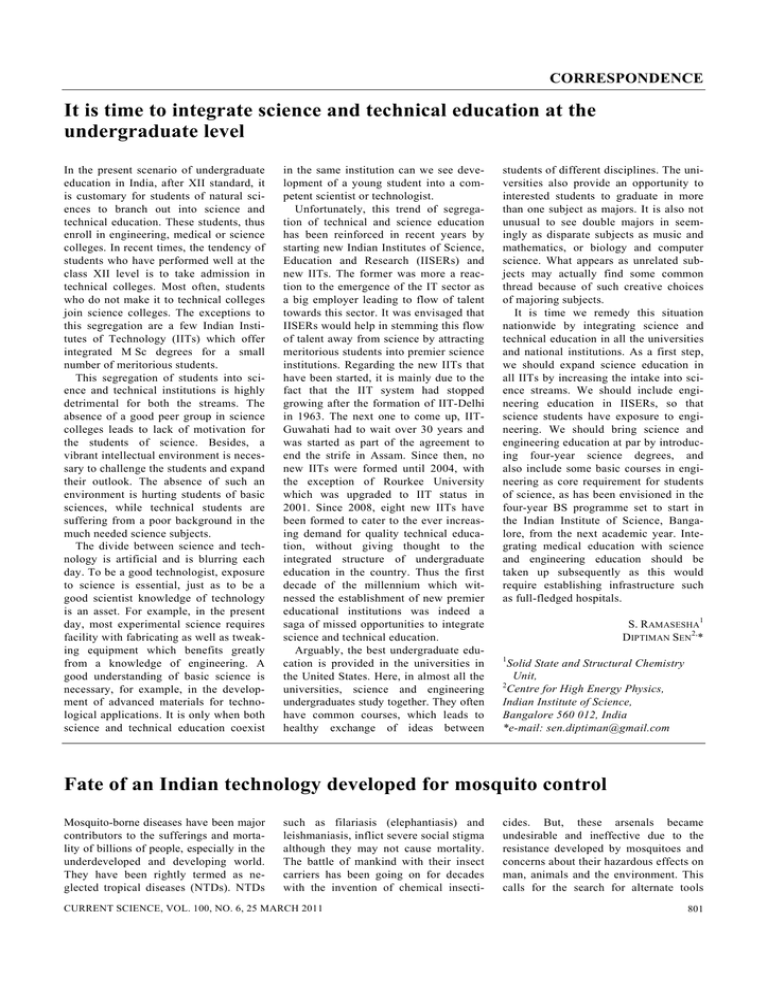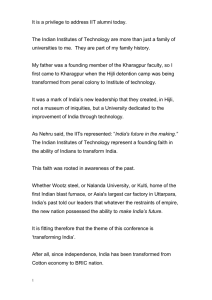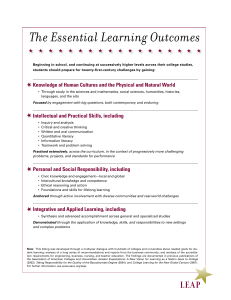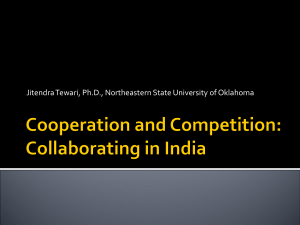It is time to integrate science and technical education at... undergraduate level CORRESPONDENCE
advertisement

CORRESPONDENCE It is time to integrate science and technical education at the undergraduate level In the present scenario of undergraduate education in India, after XII standard, it is customary for students of natural sciences to branch out into science and technical education. These students, thus enroll in engineering, medical or science colleges. In recent times, the tendency of students who have performed well at the class XII level is to take admission in technical colleges. Most often, students who do not make it to technical colleges join science colleges. The exceptions to this segregation are a few Indian Institutes of Technology (IITs) which offer integrated M Sc degrees for a small number of meritorious students. This segregation of students into science and technical institutions is highly detrimental for both the streams. The absence of a good peer group in science colleges leads to lack of motivation for the students of science. Besides, a vibrant intellectual environment is necessary to challenge the students and expand their outlook. The absence of such an environment is hurting students of basic sciences, while technical students are suffering from a poor background in the much needed science subjects. The divide between science and technology is artificial and is blurring each day. To be a good technologist, exposure to science is essential, just as to be a good scientist knowledge of technology is an asset. For example, in the present day, most experimental science requires facility with fabricating as well as tweaking equipment which benefits greatly from a knowledge of engineering. A good understanding of basic science is necessary, for example, in the development of advanced materials for technological applications. It is only when both science and technical education coexist in the same institution can we see development of a young student into a competent scientist or technologist. Unfortunately, this trend of segregation of technical and science education has been reinforced in recent years by starting new Indian Institutes of Science, Education and Research (IISERs) and new IITs. The former was more a reaction to the emergence of the IT sector as a big employer leading to flow of talent towards this sector. It was envisaged that IISERs would help in stemming this flow of talent away from science by attracting meritorious students into premier science institutions. Regarding the new IITs that have been started, it is mainly due to the fact that the IIT system had stopped growing after the formation of IIT-Delhi in 1963. The next one to come up, IITGuwahati had to wait over 30 years and was started as part of the agreement to end the strife in Assam. Since then, no new IITs were formed until 2004, with the exception of Rourkee University which was upgraded to IIT status in 2001. Since 2008, eight new IITs have been formed to cater to the ever increasing demand for quality technical education, without giving thought to the integrated structure of undergraduate education in the country. Thus the first decade of the millennium which witnessed the establishment of new premier educational institutions was indeed a saga of missed opportunities to integrate science and technical education. Arguably, the best undergraduate education is provided in the universities in the United States. Here, in almost all the universities, science and engineering undergraduates study together. They often have common courses, which leads to healthy exchange of ideas between students of different disciplines. The universities also provide an opportunity to interested students to graduate in more than one subject as majors. It is also not unusual to see double majors in seemingly as disparate subjects as music and mathematics, or biology and computer science. What appears as unrelated subjects may actually find some common thread because of such creative choices of majoring subjects. It is time we remedy this situation nationwide by integrating science and technical education in all the universities and national institutions. As a first step, we should expand science education in all IITs by increasing the intake into science streams. We should include engineering education in IISERs, so that science students have exposure to engineering. We should bring science and engineering education at par by introducing four-year science degrees, and also include some basic courses in engineering as core requirement for students of science, as has been envisioned in the four-year BS programme set to start in the Indian Institute of Science, Bangalore, from the next academic year. Integrating medical education with science and engineering education should be taken up subsequently as this would require establishing infrastructure such as full-fledged hospitals. S. RAMASESHA1 DIPTIMAN SEN2,* 1 Solid State and Structural Chemistry Unit, 2 Centre for High Energy Physics, Indian Institute of Science, Bangalore 560 012, India *e-mail: sen.diptiman@gmail.com Fate of an Indian technology developed for mosquito control Mosquito-borne diseases have been major contributors to the sufferings and mortality of billions of people, especially in the underdeveloped and developing world. They have been rightly termed as neglected tropical diseases (NTDs). NTDs such as filariasis (elephantiasis) and leishmaniasis, inflict severe social stigma although they may not cause mortality. The battle of mankind with their insect carriers has been going on for decades with the invention of chemical insecti- CURRENT SCIENCE, VOL. 100, NO. 6, 25 MARCH 2011 cides. But, these arsenals became undesirable and ineffective due to the resistance developed by mosquitoes and concerns about their hazardous effects on man, animals and the environment. This calls for the search for alternate tools 801









